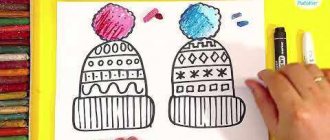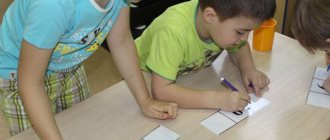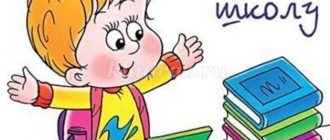Abstract of educational activities on cognitive development on the topic: “Excursion to the theater” in the 2nd junior group.
Author: Babenko Galina Pavlovna
Teacher of MKDOU Latnensky kindergarten “Rodnichok”
Abstract of educational activities on cognitive development on the topic: “Excursion to the theater” in the 2nd junior group.
Abstract of educational activities on cognitive development on the topic: “Excursion to the theater” in the 2nd junior group.
Priority educational areas:
cognitive development, speech development, social and communicative development, artistic and aesthetic development, physical development.
Target:
give children an initial understanding of the theater, its diversity and purpose.
Tasks:
Educational:
- to form children’s understanding of theater as a form of art, its diversity and purpose;
- introduce children to the professions of people working in the theater (artist, director, costume designer, set designer, musician) and the theater premises (auditorium, stage);
- to form children’s knowledge about the profession of an actor;
- consolidate knowledge about color and geometric shapes.
Educational:
- instill in children a love of theater;
- to form an emotional attitude towards literary works;
- introduce to verbal art through poetic rhymes;
- introduce the rules of behavior in the theater.
Educational:
- develop interest in theatrical and play activities;
- develop the ability to listen carefully to the teacher’s story and answer questions;
- develop the ability to listen to musical works (fragments) and relate them to literary images;
- to activate the speech activity of children, to enrich the active vocabulary on the lexical topic “Theater”;
- develop the ability to coordinate the actions of your character with the music, convey the image in motion using facial expressions, gestures, and plasticity;
- develop emotional responsiveness to music of a different nature;
- ensure optimal motor activity in the process of educational activities.
Preliminary work:
conversations: “What is theater?”, “Why do people go to the theater?”, “Who works in the theater?”, “How to behave in the theater?”, “What did I like about the theater?”; looking at pictures, illustrations on the topic, reading poems, watching a presentation about the theater.
Materials and equipment:
laptop, tape recorder, masks, theater chest, multi-colored models of geometric shapes, models - pictures “Rules of conduct in the theater”, plot pictures about the theater, sign “Theater box office”, poster, tickets, easel.
Progress of the lesson.
Educator:
Theater is a magical land!
How many miracles she gives us,
Holiday, smiles, songs and laughter
This country awaits us all!!!
Guys, have you been to the theater? (Children's answers).
What is theater?
(Teacher's story).
The theater is an amazing house where they show performances, fairy tales, where they dance and sing, and recite poems.
Educator:
Why do you guys think people go to the theater?
(Children's answers).
Adults and children go to the theater to watch a play, a fairy tale, listen to music, learn new things, and relax.
Every visit to the theater is a holiday. Let's go to the theater too. I will be your tour guide. I invite you to the easel. (Children sit near the easel on which the theater poster is placed).
Educator:
Look guys, what is this?
Bright, colorful! (Points to the poster attached to the easel).
This is a poster.
What does the poster say? Let's look at what's written on it. (Children look at the poster).
Tell me, guys, what is the name of the performance that is depicted on the poster?
(Children: “Kolobok”).
Who plays the roles?
(Children's answers).
That's right, the roles in the play are performed by actors who play a bun, grandmother, grandfather, bunny, wolf, bear, fox.
And who helps the artists? This is the director. He invites actors to play the roles of fairy-tale characters, shows the artists how to behave in order to be like their hero, and what voice to use. The director conducts rehearsals with the actors. What else can you learn from the poster? This is the date and time when the performance will take place. This is how much information we learned about the upcoming performance. And the poster helped us find out all this. What does every viewer need to have to get to the theater? Ticket. Where can I buy a ticket? At the register. This box office is called the theater box office. (Draws the children’s attention to the sign: “Theater box office”).
Educator:
Guys, stand in a circle and get your tickets.
(Hands out tickets to children).
A bell invites us into the auditorium.
(Rings the bell).
We won’t push each other, we’ll go in calmly,
And we’ll find our place with a ticket.
(Children look for their seats by the color and shape of geometric shapes: circle, square, rectangle and take them.
The color and shape of the geometric shape on the ticket must match the color and shape of the geometric shape on the back of the chair).
Educator:
Guys, show me your ticket, I'll check if you found your seat correctly.
(Children show their tickets to the teacher, he checks them).
Educator:
Do you want to be a good spectator?
(Children's answers).
Then let's get acquainted with the rules of behavior in the theater.
(He attaches pictures of “Rules of Conduct in the Theater” to the model’s easel and talks about each one in turn).
Educator:
What does this picture mean? The main rule is to maintain silence during the performance. It’s very important, guys, not to talk during the performance. What does this picture say? An important rule is to arrive on time. And this picture says that the actors need to clap when the performance is over.
Once the performance is over -
You can hear “Bravo!”, compliments;
To all the actors, in gratitude,
We give applause.
Educator:
Guys!
Show how you will clap. (Children clap their hands).
Educator:
And now I will tell you about what is in the theater.
(Display of the presentation “Theater”).
There is a wide screen in the cinema,
In the circus there is a manege or an arena.
Well, in the theater, an ordinary theater,
The platform is special - the stage.
Educator:
What is the stage like in the theater? Big, beautiful, wide. The largest theater room is the auditorium. Guys, look at the screen, what hall is it? Big, huge, beautiful, bright. Why is there so much in the auditorium? There are a lot of chairs and armchairs. How is the stage decorated? Decorated with a curtain - special curtains that are closed before the start of the performance. When the performance begins, darkness will fall in the auditorium, and the stage will be illuminated by multi-colored spotlights and spotlights.
Educator:
To make the show more interesting,
Applause was heard in gratitude,
The stage design needed is:
House, trees and other decorations.
Educator:
In order for the performance to be bright and colorful, scenery is needed.
They help the audience, us girls and boys, to find ourselves in a fairy tale near a beautiful castle, or in a dense forest near a hut on chicken legs. (Children look at images with different decorations).
Didactic game “Name the profession.”
Educator:
Guys, now we will all play a game together and name the professions of those who work in the theater.
(Based on the plot pictures, the children, together with the teacher, name the main professions: artist, director, costume designer, painter, musician).
Didactic game "Theater chest".
(Animal masks for children).
Educator:
Guys, do you want to turn into real artists?
(Children's answers).
There are different masks in my magic chest.
Choose and dress up. (Children choose masks of their choice and put them on).
Oh, my guys are unrecognizable!
Educator:
Polina, who do you want to turn into?
(Into the bunny).
What kind of hare, tell me, guys?
(Cowardly, fast).
Educator:
And who are you?
(The teacher asks all the children in turn, the children answer).
What kind of bear?
(Slow, heavy, big, bold).
What wolf?
(Hungry, gray, angry).
What kind of fox?
(Cunning, red-haired, beautiful).
Kolobok, ruddy side - which one?
(Cheerful, round, kind).
What kind of grandmother?
(Kind, caring).
Educator:
And now, we will all show together how real actors play their role.
(Music plays for each character, the character moves and dances according to his role).
Educator:
Well done boys!
Everyone did their part! You were real artists, and artists always bow after a performance. Let us also bow to each other. (Children bow).
Educator:
Now, let's all clap for each other.
(Children clap their hands).
Educator:
Guys, is it easy to be an artist?
How do you think? (Children's answers).
Not easy. Every day there is rehearsal. You must be able to laugh cheerfully, cry bitterly, dance well, sing and learn a lot of words by heart.
Didactic game “Show the mood.”
Educator:
Let's, guys, like real artists, we will also show a cheerful and joyful mood: let's smile at each other.
(Children exchange smiles).
Educator:
So you and I went to the theater and became artists. We learned so many new and interesting things about the theater.
We are very sorry to leave the theater.
We were artists so skillfully
What a pity that time flew by so quickly.
After all, everyone is happy to be an artist,
And for us, friends, it’s time to go to kindergarten!
Abstract of educational activities on cognitive development on the topic: “Excursion to the theater” in the 2nd junior group.
Goal: to expand children’s ideas about the world of theater, about theatrical professions, to stimulate their interest in theatrical art, to enrich children’s vocabulary with theatrical terms.
Equipment: illustrations of the theater premises, theater poster, theater tickets, theater programs, slides with views of various theaters, photographs of actors, fragments of various performances, didactic game “Theater Professions,” dummies of vegetables and fruits, artificial flowers, attributes for the game “Barbershop.”
Educator: Do you know what theater is, what “theater art” means, what professions people work in the theater? (children’s answers).
Theater - the art of the stage - was born in ancient times. The word THEATER came to us from the Greek language and means “place for spectacle, spectacle.” But theater is not only an art form, but also a building where we come to performances.
Want to take a tour of the theater? (Illustrations of various theater buildings are exhibited).
Here is a house, big, beautiful, elegant, old. This is the theater building. Look, in front of him is a colorful, bright poster - a theater poster, which, using drawings, photographs and various words, contains information about upcoming performances in the theater (author of the play, director, actors who play the main roles, title, date and time of the performance). Let's go into this beautiful house. Where have we ended up? Look, we see a small window on which is written “Theater Box Office”.
Come to the window
Give him the money.
And a little window in response
Gives you a ticket.
A theater box office is a place where tickets for theater performances are sold. They contain the name of the theater, the name of the performance, its author, the date and beginning of the performance, as well as the place and row in the auditorium. A cashier sells tickets at the theater box office. Upon entering the theater, the ticket attendant checks the spectators' tickets. A theater performance usually takes a long time, more than an hour. It will be uncomfortable for spectators to sit in outerwear. What should I do? Where should viewers go first? (Children's answers). In the theater, the locker room is called a wardrobe, and the profession of the person who accepts the audience's outerwear is a cloakroom attendant. The cloakroom attendant gives you a number, you clean yourself up and move on.
Are you interested in knowing what today's performance will be about, what actors will play in it? Then you and I simply need to purchase a theater program from the theater employee, the usher. Look, it indicates the characters (heroes) of the play, as well as the names of the actors who play the roles of these characters. The program may also contain a brief description of the performance.
So, you and I are spectators. The performance will begin soon and it’s time for us to go to the auditorium. But what is it? Which of you is the most attentive and heard an unusual sound? This is a theatrical call. In total, the theater rings three bells before the start of the performance. The third bell indicates that the performance is beginning. After the third ring, the lights in the hall go out. It is indecent to enter the auditorium after the third bell. Before the third bell rings, let's take a closer look at the auditorium. This is the largest room of the theater. Take a closer look, do you like it? What makes an auditorium beautiful? (Walls, lamps, in the center of the ceiling there is a huge chandelier). Do you have chandeliers at home? Are they the same as this one? (Children's answers). This chandelier is very large, as the auditorium itself is huge. When the performance begins, this chandelier will go out, darkness will fall in the auditorium, and special spotlights will illuminate the stage. Soffits are special lamps in the auditorium that illuminate the stage from the front and above. With the help of spotlights, lighting designers can depict sunrise or sunset, flashes of lightning, starry skies and much more on stage.
Let's take our seats in the auditorium. How to do it? (See what is indicated on the ticket). The seat you should sit in is indicated on your theater ticket. Parterre - front, bottom rows, amphitheater - top, back. If you are sitting far from the stage, you will need theater binoculars, which you can bring with you or purchase from the cloakroom.
Let's take a look at our auditorium. The most important place in the auditorium is the stage on which the performance is performed. The scene itself is not yet visible. It is still closed with a curtain. A theater curtain is a piece of cloth that covers the stage from the audience. Curtains are made of thick, dyed fabric, folded and decorated with theater emblems or wide fringe sewn to the bottom of the curtain. The performance will begin as soon as the curtain rises or moves apart, as they are sliding or rising.
Many performances in theaters are accompanied by music. Where do you think the musicians sit, is it really on the stage? (Children's answers). The orchestra pit is a special room for the orchestra in the theater, located in front of the stage.
Before the audience can see the performance, people of different professions prepare it for a long time. Let's list them and try not to forget anyone! (Theater professions)
• The scenery for the performance is made in the painting and decoration workshop according to the sketches of the decorative artists.
• Prop - fake, specially made objects of sculpture, furniture, dishes, used in theatrical performances instead of real things. A theater worker who makes props is called a prop maker.
(The teacher shows the children fake things as examples: dummies of vegetables and fruits, artificial flowers, etc.).
• The sound for the performance - the phonogram - is prepared by the sound engineer. During the performance, he can turn on any soundtrack: the sound of rain or the roar of waves, the roar of the crowd or the whistle of the wind.
• Actors for a performance may need a variety of costumes: ancient and modern, fairy-tale and ordinary. The profession of a person who sews and makes suits is called a “costumer.”
• Before the performance, the make-up artist applies makeup to the actors. An experienced make-up artist can change an actor's face beyond recognition.
• The director chooses which play to stage, assigns roles, organizes and conducts rehearsals and everything that happens on stage.
• An actor is a person who plays a role in a play.
• A person who monitors the progress of the performance, the performance of the actors, and can, if necessary, suggest the words of the role to the actors - a prompter.
• A person who leads (conducts) an orchestra of musicians is called a conductor.
A didactic game “Theater Professions” is being held
Today our performance is on stage for the first time, so today is the premiere of this performance. So, the first act (part) of the play began.
(Children are invited to look at the illustrations of any children's performance or watch a video).
Are you tired, do you like our performance? The actors play wonderfully! Do you think they need to rest and prepare for the continuation of the performance?
(Children's answers)
The break between the actions of the play is called intermission. During intermission, all spectators usually go out into the theater foyer. At this time, you can go to the buffet, clean up in the toilet room, and also get acquainted with various photographs of theater artists that are hung on the walls of the foyer.
(Children look at photographs of Perm theater artists and excerpts from the performances in which they played).
Our performance has come to an end. Did you like him? How can we express this without words? Should I thank the actors for their wonderful performance? That's right, applause! Applause is a form of expressing gratitude to artists. If you liked the acting, give it a round of applause! You can also give them flowers.
Educator: We learned a lot of interesting things about the theater today. But there is a special place in it, which is called the mysterious word “backstage” - what is behind the stage. Today we were allowed to visit there with you. You can find a lot of interesting things here. The audience does not see this space. The actors and employees of the theater have their own entrance from the street, leading directly to the stage. Let's get acquainted with the premises of the “backstage kingdom”.
(The teacher lists these rooms and explains their purpose: decorator and props workshop, costume room, actors’ dressing room).
Educator: let us go into one of these rooms. Look, a table! Is he wearing a mirror, paints, powder, makeup, wigs? What kind of room is this? (Children's answers). That's right, this is the actors' dressing room. Let's now play actors and make-up artists, make princesses out of girls, and grandfathers out of boys.
(Children distribute the roles of make-up artists and actors among themselves and the transformations begin before everyone’s eyes)
The children then “return” back to kindergarten.
Summarizing:
Educator: What new did you learn? What surprised you the most? What did you remember? What new words did you meet, etc.
Conversation on the topic “Getting to know the theater” with children of the senior group
DRAMA THEATER
In a drama theater, actors are talking. The playwright talks about the characters and events in the play through dialogues.
THEATER OF BEASTS
The oldest theater exists in Moscow - the theater of V. L. Durov. “Grandfather Durov’s Corner”, where animals perform: hippopotamus, elephant, raven, pelican, raccoon and many others.
PUPPET SHOW
There are puppet theaters where spectators look not at live performers, but at puppets controlled by the performers: glove dolls, marionette dolls, shadow theater.
AUDITORIUM
Let's take a look at the auditorium. The most important place in the auditorium is the stage on which the performance is performed. The scene itself is not yet visible. It is still closed with a curtain. If you are sitting far from the stage, you will need theater binoculars, which you can bring with you or purchase from the cloakroom.
PARTERRE, BENOIR, MENS ELECTA, 1st LEVEL, 2ND LEVEL, BALCONY
ORCHESTRA PIT. Musical operas and ballets, in opera the artists sing, they are called soloists, and they are assisted by choreographers and an orchestra. The orchestra is led by a conductor so that the musicians play in the same rhythm and tempo, and in ballet the artists dance. A choreographer helps them in staging the dance. The musicians are sitting in the orchestra pit. The orchestra pit is a special room for the orchestra in the theater, located in front of the stage.
A CURTAIN. What is a theater curtain? This is a canvas that covers the stage from the audience. The performance will begin as soon as the curtain rises or moves apart, as they are sliding or rising.
SCENERY. The scenery for the performance is made in the workshop according to the sketches of the decorative artists. The scenery for the performance is made in the painting and decoration workshop according to the artists’ sketches.
PROPS. Props are fake, specially made objects of sculpture, furniture, and dishes used in theatrical performances instead of real things. A theater worker who makes props is called a prop maker. Crockery, food, weapons, and furniture can be props.
SPOTS. With the help of spotlights, lighting designers can depict sunrise or sunset, flashes of lightning, starry skies and much more on stage.
During a performance, a sound operator can turn on a soundtrack: the sound of rain or the roar of waves, the roar of a crowd or the whistle of the wind - depending on what is happening on stage at that time.
MAKE-UP MAKER. Before the performance, the make-up artist applies makeup to the actors. An experienced master can change an actor's face beyond recognition. Actors for a performance may need a variety of costumes - ancient, modern, and even fairy-tale.
The entire costume must first be designed and then drawn by the artist. The tailors will then bring his ideas to life. Masters can paint a piece of burlap in such a way that from the audience it will seem like rich brocade, velvet or silk.



